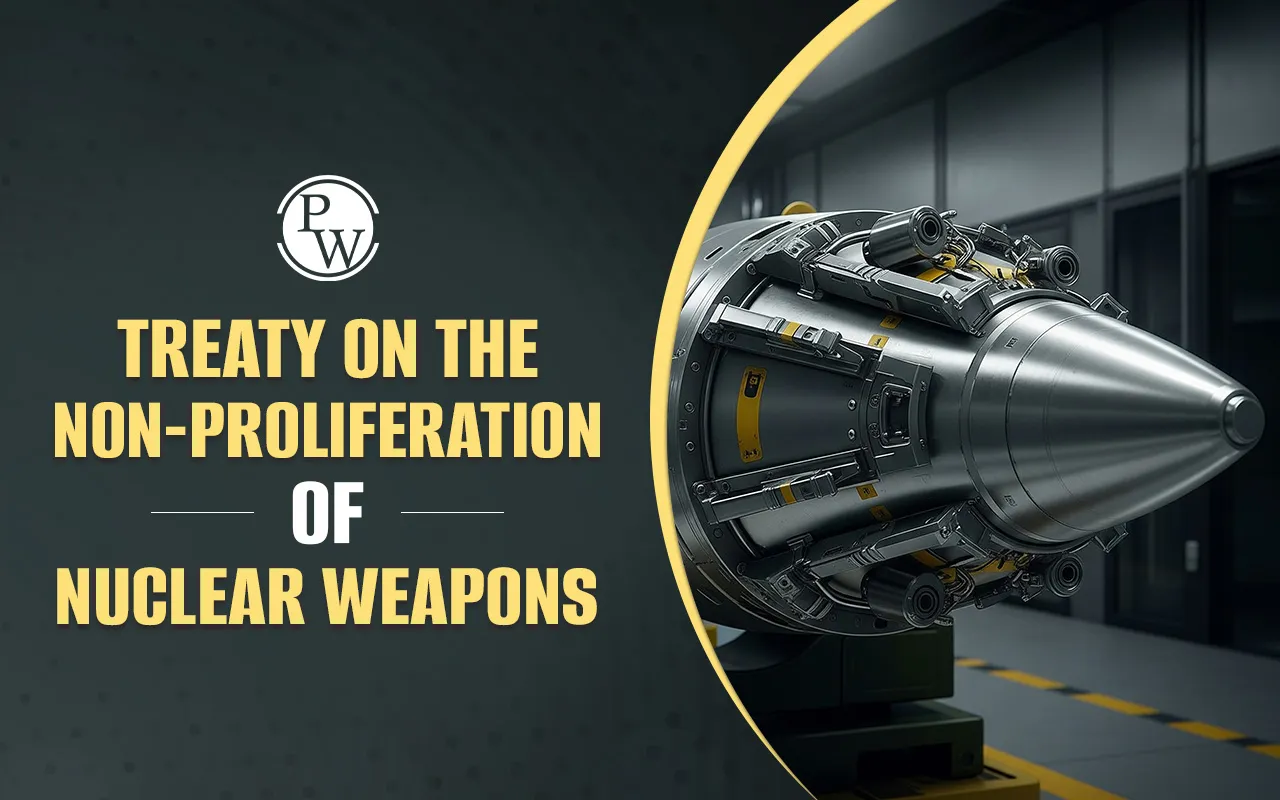
Treaty on the Non-Proliferation of Nuclear Weapons (NPT) is one of the most important international agreements in the field of nuclear arms control. It was designed to stop the spread of nuclear weapons, promote peaceful uses of nuclear energy, and work towards disarmament. First signed in 1968 and enforced from 1970, the treaty plays a key role in maintaining global security and preventing nuclear conflict. Read on to learn more about NPT.
The NPT is a legally binding international agreement aimed at preventing the spread of nuclear weapons and technology. It also encourages cooperation in the peaceful use of nuclear energy and aims for complete disarmament in the long run. The treaty divides countries into two groups:
Nuclear-Weapon States (NWS): Countries that tested nuclear weapons before 1 January 1967 (USA, Russia, UK, France, China).
Non-Nuclear-Weapon States (NNWS): All other countries that agree not to develop nuclear weapons.
Background: Opened for signature in 1968 and entered into force in 1970.
Membership: 191 States.
The idea of nuclear disarmament began after the horrific bombings of Hiroshima and Nagasaki in 1945. The Cold War between the USA and the USSR saw a sharp rise in the number of nuclear weapons, raising fears of global destruction. The Cuban Missile Crisis of 1962 was a major turning point.
It made the world realise the dangers of nuclear conflict. In response, discussions on a treaty to limit nuclear arms began. After long talks, the NPT was opened for signature on 1 July 1968 and came into force on 5 March 1970. It was extended indefinitely in 1995. The International Atomic Energy Agency (IAEA) was given the job of inspecting and verifying compliance.
The NPT is one of the most widely signed arms control treaties in the world. As of now, 191 countries are parties to the treaty. Treaty on the Non-Proliferation of Nuclear Weapons countries are grouped into:
United States
Russia
United Kingdom
France
China
These five countries are also the permanent members of the United Nations Security Council (UNSC).
Rest of the member countries agreed not to pursue nuclear weapons in exchange for access to peaceful nuclear technology, including Japan, Germany, Brazil, South Africa, etc.
India
Pakistan
Israel
South Sudan (which became independent in 2011)
North Korea joined the NPT in 1985 but withdrew in 2003.
The Treaty on the Non-Proliferation of Nuclear Weapons 1968 is based on three key pillars, each with its own responsibilities:
Article I: Nuclear-weapon states must not transfer nuclear weapons or aid non-nuclear-weapon states (NNWS) in acquiring them.
Article II: NNWS must not develop or acquire nuclear weapons.
Article III: NNWS must adopt IAEA safeguards to ensure nuclear materials are used only for peaceful purposes.
Article VI requires all parties to pursue "negotiations in good faith" toward nuclear disarmament and general complete disarmament
However, disarmament has seen slow progress, which has caused dissatisfaction among NNWS.
Article IV guarantees all states the "inalienable right" to peaceful nuclear technology, including energy production, provided they comply with non-proliferation rules
NNWS can get access to nuclear technology under safeguards and monitoring.
The treaty also includes a review conference every 5 years to assess its implementation.
No, India has not signed the NPT because of its discriminatory nature. The treaty allows only five countries to have nuclear weapons based on a cut-off date (before 1967). India argues that this legalises inequality in global nuclear power. Here are the key reasons for India’s opposition to Treaty on the Non-Proliferation of Nuclear Weapons:
It does not recognise India’s nuclear capabilities.
It does not offer any disarmament timeline for existing NWS.
It restricts India’s access to nuclear technology unless it agrees to inspections.
India conducted its first nuclear test in 1974 (Pokhran-I) and another series in 1998 (Pokhran-II). India supports nuclear disarmament but wants a fair, non-discriminatory global framework.
Besides the NPT, several other international agreements aim to limit or eliminate nuclear weapons:
Comprehensive Nuclear-Test-Ban Treaty (CTBT): Adopted in 1996 but not yet in force, CTBT bans all nuclear explosions for any purpose. India has not signed it.
Strategic Arms Reduction Treaty (START I & II, New START): These are bilateral treaties between the US and Russia to reduce nuclear arms, with the latest version, New START, signed in 2010 and extended till 2026.
Treaty on the Prohibition of Nuclear Weapons (TPNW): Entered into force in 2021, TPNW is the first legally binding treaty to completely ban nuclear weapons, though none of the NWS have joined it. It has not been signed by India.
These treaties reflect global efforts towards a nuclear-free world, even though achieving complete disarmament remains a challenge.
UPSC PYQs Related to NPTUPSC Prelims 2018: What is/are the consequence/consequences of a country becoming the member of the ‘Nuclear Suppliers Group’?
Which of the statements given above is/are correct? (a) 1 only UPSC Prelims 2015: Consider the following countries:
Which among the above are Nuclear Weapons States as recognized by the Treaty on the Non-Proliferation of Nuclear Weapons, commonly known as Nuclear Non-Proliferation Treaty (NPT)? (a) 1 and 2 only |
In essence, the Treaty on the Non-Proliferation of Nuclear Weapons remains a key pillar of global peace and security. However, issues like unequal rights and lack of progress on disarmament still raise concerns.
Explore more such important international treaties and topics with UPSC Courses by Physics Wallah. Enroll now!

UPSC Coaching